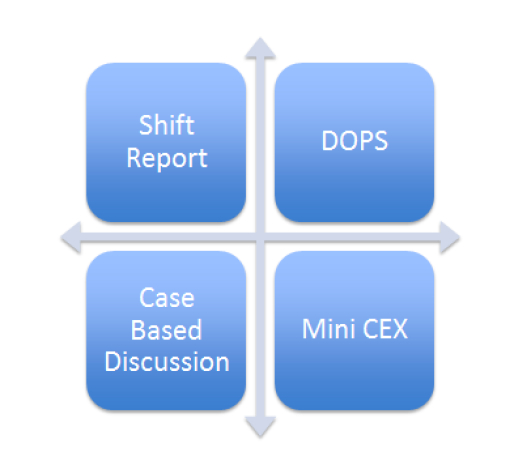Work Based Assessment 2015
Work based Assessment, also known as ‘WBA’, is becoming an important part of future training in Emergency Medicine.
The Australasian College of Emergency Medicine (ACEM) has undertaking a full-scale curriculum redevelopment project over the last 4 years or so and decided to refine the Major Exam that marks the end of FACEM training.
In making these major changes the college of Emergency Medicine is transferring some of the final FACEM exam’s classic components into a continuous assessment program. These components known as ‘WBA’ will be carried out in the individual hospitals. At least in theory, this program matches most robust adult learning theories.
WBA will aim to avoid the visceral “mad rush to the finish” that many of those who sat the old Fellowship Exam will remember all to well.
Why WBA?
ACEM 2014 – “Assessment in postgraduate medical education is changing and ACEM is ensuring its training program reflects contemporary best practice. As a result, the high stakes Fellowship Exam at the end of training will be complemented by multiple WBAs that are performed throughout training by local assessors, and collectively judged by a review panel to determine progression.”
Principles Behind the Changes – The New CANMEDS Style Curriculim
On this page we will review the WBA components and gradually develop resources to help get through the various components of the new continuous assessments. As a result of the recent WBA trial carried out by ACEM and further evaluation of the WBA components, the WBA Paperwork/Forms and the DOPS list have been updated. The main changes include revision to the rating scale (for example, the numbers 1-9 have been removed), the definitions for some of the components have changed (e.g. the consultation on Mini-CEX) and requirements for DOPS have been updated. We have outlined these recent changes in the discussions below.
The Paperwork
Paperwork for the WBA will be completed online by the Trainee and a Registered assessor.
The scale of assessment is determined by the degree of independence the assessor feels the trainee should be given:

The Components
- Mini Clinical Examination (Mini CEX)
- Direct Observation of Procedural Skills (DOPS)
- Cased Based Discussions
- Shift Reports
The Assessors
Assessors will be a local FACEMs who have been approached by the trainee for an assessment.
Local FRACPs may also act as assessors for the WBA
Assessor Calibration Module Link
The 4 Components
Mini Clinical Examination (Mini-CEX)
- The Mini Clinical Examination (Mini-CEX) comprises either being assessed on taking a history OR examining a patient.
- Patient communication tasks may also be used
- During aMiniCEX trainees will be directly observed bytheirFACEMassessor carrying out a
- Examinations will be assessed at a similar standard to short cases in the ‘old’ FACEM exam: Click Here
MINI-CEX FORM – CLICK HERE
Direct Observation of Procedural Skills (DOPS)
- DOPS may consist of Clinical or Non-clinical Tasks
- Approximately 20 – 30 minutes should be allocated for observation and feedback for the trainee.
.
Procedures
- Core DOPS Procedure List
- Advanced Airway (including: direct laryngoscopy, insertion of oral ETT, use of RSI technique [including drugs, stylet, bougie]).
- Use of non-invasive ventilation device (either: adult or paediatric)*
- Tube thoracostomy
- DC Cardioversion
- Emergent fracture/ dislocation reduction
- Lumbar Puncture
- Administration of procedural sedation
- Central venous access (either: ultrasound guided central vascular access or insertion of a central venous line)*
- Arterial line insertion
- Suturing (either: basic skin suturing techniques or advanced suturing techniques)*
- Nerve block with or without ultrasound (either: digital nerve block or femoral/fascia iliaca block)*
- Nasal packing (either: anterior or posterior)*
For the Core DOPS Procedure Requirement to be met, a trainee must complete at least 50% of the minimum number of DOPS assessments on the procedures selected from the Core DOPS Procedure List (see above). Procedures in the list marked with an asterisk include an option, so to complete these procedures the trainee need only undertake one of the options presented. Completion of more than one option within the same procedure on the CoreDOPS List can only be counted as one procedure towards the CoreDOPS Procedure requirement. The remaining requirement for DOPS procedures can be made up from the full list from the New ACEM Curriculum.
- Further DOPS Options (The New Curriculum Procedures List):
DOPS FORM – CLICK HERE
Case Based Discussion (CbD)
- The assessor engages the trainee in a detailed retrospective discussion of a selected case
- The trainee should bring three cases for discussion with a similar curriculum theme (e.g. cardiovascular system)
- A similar standard to the “old” exam long case will be required for high-end marks in this assessment
- The skill set for the Long Case can be found on the FACEM exam page – Click Here
CBD FORM – CLICK HERE
Shift Reports
- The trainee is observed at multiple time points during a clinical shift
- Usually for a Shift Report trainees will arrange this in advance with the “on the floor” consultant
- Trainees will be observed an assessed on:
- Clinical handover
- And three other areas: e.g. Leadership, Communication, Professionalism and Teaching
- Senior Trainees (in transition between new and old system) are required to complete shift reports
SHIFT REPORT FORM – CLICK HERE
Confused?
Don’t Worry. This is a new process and there is a degree of uncertainty around how things will pan out in 2015-16 and beyond. Any immediate queries should be directed to the Emergency College @ wba@acem.org.au





Thanks to Dr Bob Clarke for the excellent external links – http://www.faculty.londondeanery.ac.uk/other-resources/multiprofessional-podcasts-for-clinical-educators
I thinks these are especially helpful for supervisors new to the ACEM WBA but also for trainees that need to understand the “method behind the madness”